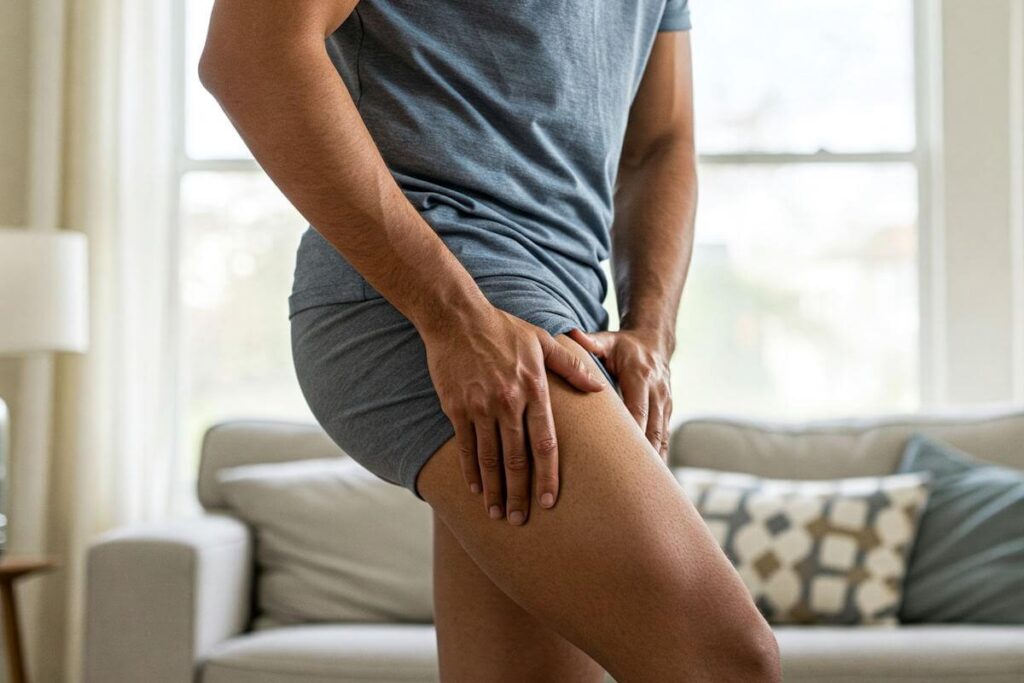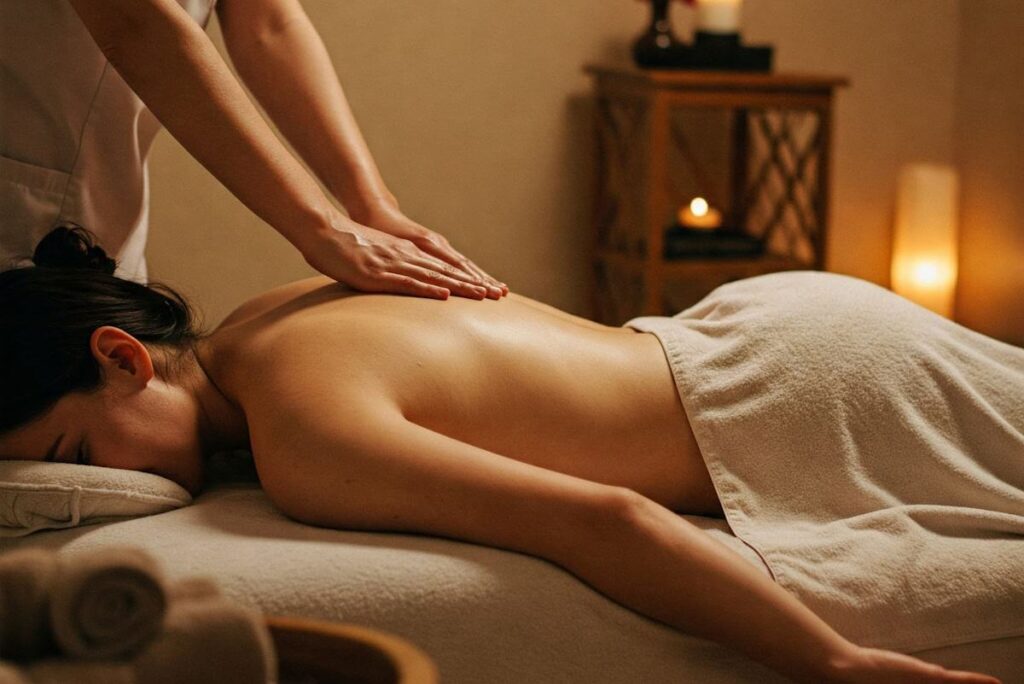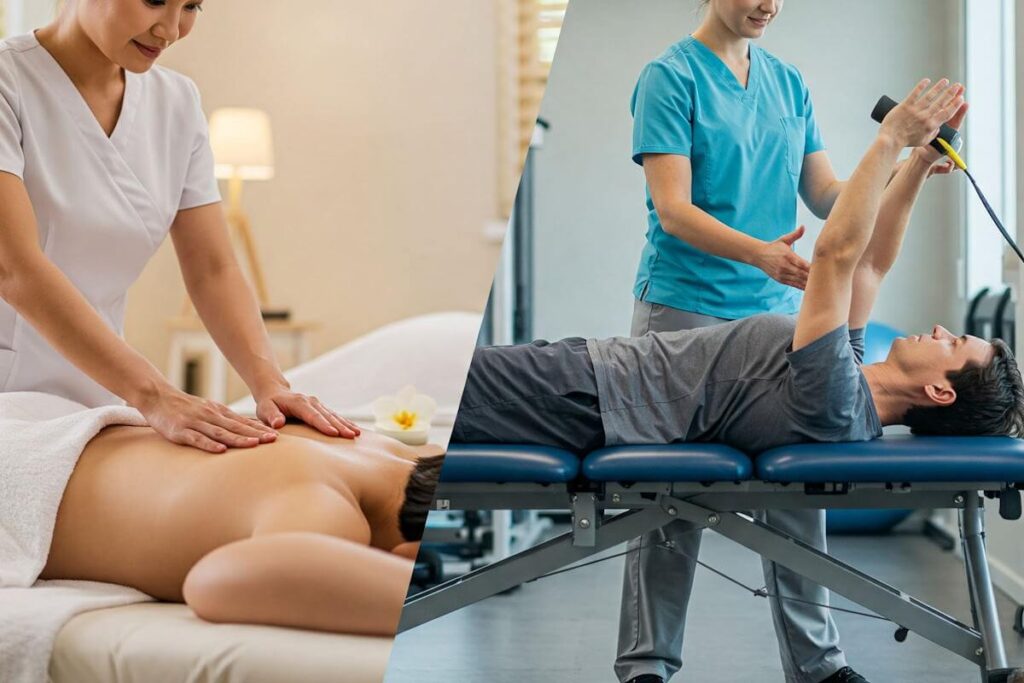Introduction to Self-Massage
Self-massage is a practice that has been utilized for centuries across various cultures, rooted in ancient healing techniques and holistic approaches to well-being. By incorporating elements from traditional practices such as Ayurvedic medicine, Shiatsu, and Swedish massage, self-massage has evolved into an accessible method for individuals seeking relief from physical and mental stressors. As modern life becomes increasingly hectic, the relevance of self-massage has grown, offering a simple yet effective means of promoting relaxation and self-care.
The benefits of self-massage are numerous and far-reaching, making it an appealing practice for people of all ages and backgrounds. Primarily, self-massage is recognized for its ability to alleviate accumulated tension in the muscles, which can arise due to prolonged periods of sitting, engaging in strenuous activities, or emotional stress. Regular practice can also improve circulation, enabling better blood flow throughout the body, thus aiding in faster recovery from injuries and reducing soreness that can accompany physical exertion.
Moreover, engaging in self-massage can significantly enhance one’s mental and emotional well-being. The act of massage can trigger the release of endorphins, the body’s natural mood elevators, which help to alleviate stress, anxiety, and even symptoms of depression. This holistic approach not only addresses physical discomfort but also fosters a deeper connection to the individual’s body and mind, encouraging greater awareness and mindfulness.
In a world where self-care often takes a back seat to daily responsibilities, self-massage serves as a practical and cost-effective solution. It requires no specialized skills or expensive equipment; rather, the most effective tools are one’s own hands. This makes self-massage an empowering practice that anyone can incorporate into their daily routine, promoting overall well-being by providing a sanctuary of relaxation amid life’s chaos.
Understanding the Benefits of Self-Massage
Self-massage is a therapeutic technique that can yield numerous benefits for individuals seeking relief from daily stressors and physical discomfort. One of the primary advantages of self-massage is its ability to alleviate pain, particularly in areas that often suffer from tension, such as the neck, shoulders, and lower back. By applying targeted pressure on specific muscle groups, individuals can help relieve tightness and reduce discomfort, contributing to an overall sense of well-being.
Another significant benefit of self-massage is its effect on muscle tension reduction. Regular practice can help to relax overworked muscles, facilitating increased blood circulation and promoting healing. This enhanced circulation not only nourishes the muscles but also aids in the removal of metabolic waste. Consequently, self-massage can improve physical performance and speed up recovery after exercise, making it a valuable practice for athletes and fitness enthusiasts alike.
In addition to physical benefits, self-massage can also serve as an effective method for achieving overall relaxation. The simple act of dedicating time to oneself can stimulate the release of endorphins, which are natural mood enhancers. This biochemical reaction can uplift your spirits, reduce anxiety, and improve emotional well-being. Moreover, integrating self-massage into your daily wellness routine can enhance sleep quality, as the calming effects of self-massage prepare both the mind and body for restful slumber.
Flexibility is another area in which self-massage can significantly contribute. By loosening tight muscles and enhancing mobility, individuals may find it easier to engage in physical activities and maintain an active lifestyle. Overall, self-massage is a multifaceted approach to health, offering a holistic method to improve both physical and mental states. By incorporating self-massage techniques into your routine, you can foster a deeper connection with your body and promote a healthier, more balanced life.
Essential Tools for Self-Massage
Self-massage is an effective way to alleviate tension, reduce stress, and promote overall well-being. Utilizing specific tools can enhance the massage experience and target various areas of discomfort. Here are several essential self-massage tools that can help individuals optimize their sessions at home.
Massage Balls: These compact tools are ideal for targeting trigger points and knots in the muscles. They are available in various sizes and densities, allowing users to tailor their self-massage techniques to their unique needs. A lacrosse ball or a tennis ball can be particularly effective for working on the neck, shoulders, and feet. By placing the ball between the body and a hard surface, users can apply pressure to specific muscle groups and relieve discomfort effectively.
Foam Rollers: Foam rollers are widely recognized for their ability to perform myofascial release, which helps alleviate soreness and improve flexibility. These cylindrical tools come in different textures, ranging from smooth to ridged surfaces. They are particularly beneficial for larger muscle groups such as the back, thighs, and calves. To use a foam roller, individuals can roll their bodies over the tool, applying gentle pressure to tight areas and allowing for deeper tension relief.
Massage Sticks: A massage stick is a handheld tool designed to deliver targeted pressure to muscles while promoting circulation. This tool is particularly useful for athletes or those who engage in physical activities, as it can effectively address soreness in the legs and arms. Users can easily glide the stick over the muscle groups, allowing for controlled pressure and varying techniques based on preference.
Choosing the right tool depends on personal comfort, the specific areas needing attention, and the intensity of pressure desired. Individuals should consider experimenting with different tools to determine which ones resonate with their self-massage practice, thus enhancing their overall wellness experience.
Basic Self-Massage Techniques
Self-massage is a valuable practice that promotes relaxation, reduces tension, and enhances overall well-being. By employing simple techniques such as kneading, rolling, and tapping, individuals can effectively relieve muscle stiffness and improve circulation without the need for specialized tools. Each technique can be easily performed at home, allowing for personalized care and attention to various body areas.
The kneading technique involves applying pressure with the fingers, thumbs, or palms to specific muscle groups. To perform this effectively, locate a tense area and use a circular motion, gradually increasing the pressure as needed. Kneading is particularly beneficial for larger muscle groups, such as those in the back and thighs. By focusing on knots and tight spots, individuals can release pent-up tension and promote muscle relaxation.
Another effective method is rolling, which can be conducted using the palms or forearms. This technique facilitates the stretching of muscles and fascia, enabling enhanced flexibility. Users can roll their hands along their legs, sides, or back, employing a back-and-forth motion to alleviate tightness. For optimal results, apply gentle pressure initially, and adjust according to personal comfort levels.
Tapping is a self-massage technique that involves lightly tapping the fingers or palms on various body parts. This rhythmic motion stimulates circulation and provides a gentle energizing effect. Focus areas can include the arms, legs, or even the scalp. Tapping is excellent for awakening tired muscles and promoting a sense of vitality.
When practicing these techniques, monitoring the pressure applied to different areas is essential to avoid discomfort. Attention should be given to sensitive or inflamed regions, as excessive pressure may lead to adverse effects. By incorporating these basic self-massage methods into daily routines, individuals can enjoy improved physical and mental health.
Targeting Specific Areas: Neck and Shoulders
The neck and shoulders are often a repository for tension due to stress, poor posture, and prolonged sitting. Practicing self-massage techniques in these areas can significantly enhance relaxation and alleviate stiffness. To begin, find a comfortable seated position. It is essential to ensure that your back is straight to prevent further strain while engaging in self-massage.
Start with the neck. Use your fingers to apply gentle pressure along the sides of the neck, moving from the base of the skull down to the shoulders. Employing a circular motion with your fingertips will help to loosen tight muscles. You may also utilize your thumb to press directly into the muscle tissue, targeting any knots or tender spots. Remember to breathe deeply as you massage, as this encourages relaxation and blood flow.
Next, shift your focus to the shoulders. Using both hands, grasp the top of your shoulder and knead the muscle. Adjust the pressure based on your comfort level—more pressure may be suitable for stiff areas while gentle manipulation can help in sensitive spots. Another effective technique is to pinch the muscle between your fingers and thumb, then hold for a few seconds before releasing.
Stretching can also complement your massage routine. Slowly tilt your head to one side, bringing your ear toward your shoulder. Hold for 15-30 seconds to stretch the muscles effectively. Repeat on the opposite side. Incorporating these stretches and self-massage techniques can greatly improve mobility while reducing discomfort. Regular practice may yield significant improvements in muscle tension and overall well-being in these crucial areas.
Soothing Techniques for the Back
Back pain is a prevalent issue affecting individuals of various ages and lifestyles. Employing self-massage techniques can be an effective way to alleviate discomfort and tension in the back region. One effective method involves using a foam roller. By positioning a foam roller beneath specific areas of the back, individuals can utilize their body weight to apply pressure, helping to release muscle knots and improve blood circulation. It is crucial to slowly roll over the foam roller, concentrating on sensitive spots and avoiding any abrupt movements that could cause further discomfort.
Another technique for self-massage focuses on the use of a tennis ball. This method is particularly useful for targeting the hard-to-reach areas along the upper and lower back. To perform this technique, locate a wall and place a tennis ball between your back and the wall. By gently leaning against the wall and moving the ball in circular motions, you can effectively massage the muscles and alleviate tension. This technique is particularly beneficial for individuals with a sedentary lifestyle or those who experience tightness from prolonged sitting.
Stretching is also an essential component of any back self-massage routine. Combining the techniques above with gentle stretches can enhance the overall efficacy of muscle relaxation. For instance, while lying on your back, bring your knees to your chest and hold this position for several seconds. This stretch helps to release tension in the lower back and promotes relaxation throughout the entire spinal column.
Incorporating these self-massage techniques into your regular routine can significantly improve the management of back pain. By utilizing tools such as a foam roller or tennis ball, along with effective stretching practices, individuals can foster a deeper sense of relief and comfort in their back region. Regular self-massage not only addresses pain but also promotes relaxation and contributes to overall well-being.
Self-Massage for Hands and Feet
Hands and feet are essential components of our daily lives, often bearing the brunt of our activities without receiving the attention they deserve. Engaging in self-massage for these areas can yield significant benefits, including easing fatigue, enhancing circulation, and promoting relaxation. The hands and feet are particularly prone to tension due to their frequent use, making self-massage an effective way to revitalize them.
To start, a simple technique for the hands involves using the thumb of one hand to press into the palm of the other. Begin at the base of the palm, applying gentle pressure and moving towards the fingers. Focus on the areas between the fingers and the knuckles, as these often harbor tension. Another effective method is the kneading technique, where you can use the same thumb-and-finger combination to grasp and gently squeeze the fleshy parts of your palms. This can enhance blood flow and alleviate soreness.
When it comes to the feet, a popular approach is to roll a tennis ball underfoot. This can help to release tightness and improve circulation. Simply position a ball on the floor and roll your foot over it, applying as much pressure as comfortable. For a more targeted massage, use your thumbs to apply pressure to the arch and heel of the foot, moving in small circular motions. This technique helps in relieving fatigue, especially after a long day of standing or walking.
Additionally, integrating essential oils such as lavender or peppermint during your self-massage can offer further relaxation benefits. These scents not only enhance the experience but also contribute to the overall soothing effect. Regularly incorporating hand and foot massages into your routine can cultivate a greater awareness of your body, fostering a deeper sense of wellbeing that can influence your daily activities positively.
Incorporating Aromatherapy and Music
Integrating aromatherapy and music into your self-massage routine can significantly enhance the experience, making it more enjoyable and effective. Aromatherapy utilizes essential oils derived from plants to promote physical and emotional well-being. Specific essential oils, such as lavender, chamomile, and eucalyptus, are particularly well-known for their calming properties and can be beneficial in creating a serene environment.
To utilize aromatherapy, consider starting with a diffuser to disperse the essential oils throughout the room. For relaxation, lavender oil is an excellent choice; its soothing aroma has been shown to reduce anxiety and tension. Chamomile is another essential oil that can provide tranquility, helping to ease both the body and mind. Eucalyptus oil, known for its refreshing scent, may help clear the mind and promote breathing ease, making it particularly useful during a massage focused on the upper body and shoulders.
In addition to essential oils, the power of music should not be underestimated. A carefully curated playlist can create an ambiance that encourages relaxation and mindfulness during your self-massage session. Consider instrumental music or natural sounds, such as ocean waves or forest ambiance, which can promote a tranquil environment. The gentle melodies and soothing rhythms can help you settle into a relaxed state, allowing you to concentrate better on the areas needing attention.
Creating a space that integrates both aromatherapy and calming music can elevate your self-care routine. By engaging multiple senses, you allow your body to fully embrace the self-massage experience while fostering an atmosphere conducive to relaxation. Ultimately, taking the time to incorporate these elements into your practice may lead to greater physical relief and mental clarity.
Creating a Self-Massage Routine
Establishing a personalized self-massage routine can significantly enhance your overall well-being. To begin, it’s important to assess your lifestyle and specific needs. Consider factors such as stress levels, physical activity, and areas where you tend to hold tension. By identifying these elements, you can tailor a routine that focuses on relieving tension and promoting relaxation.
Scheduling plays a crucial role in integrating self-massage into your daily life. It may be helpful to set aside a specific time each week dedicated to this practice. Whether it’s a 10-minute session in the morning to invigorate your body or a longer evening routine aimed at winding down, consistency is key. One strategy is to align your self-massage with other regular activities, such as showering or practicing yoga. This ensures that self-care becomes a seamless part of your routine.
The frequency of your self-massage sessions should be determined based on your individual needs and availability. Some individuals may benefit from daily sessions focusing on specific areas, while others might find that a couple of sessions per week suffice. It is vital to listen to your body and adjust the routine as necessary. Over time, you may also explore various techniques, such as Swedish massage or trigger point therapy, to combine and enhance your practice. Switching between methods will not only prevent routine monotony but also address different muscle groups effectively.
Ultimately, making self-massage a regular practice encourages self-awareness and empowers individuals to take charge of their own well-being. By creating a structured yet flexible routine, you can cultivate a beneficial habit that promotes relaxation, reduces stress, and enhances your overall quality of life. The art of self-massage can be a powerful tool in your self-care arsenal.




